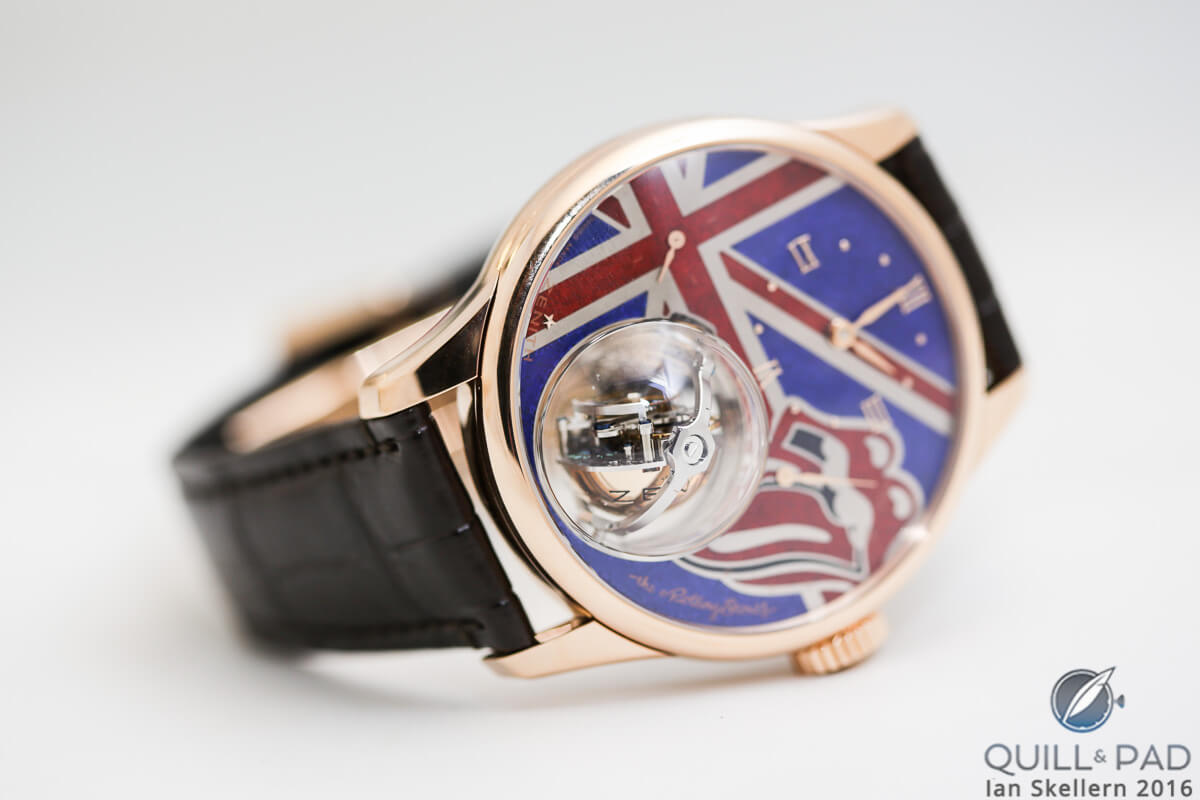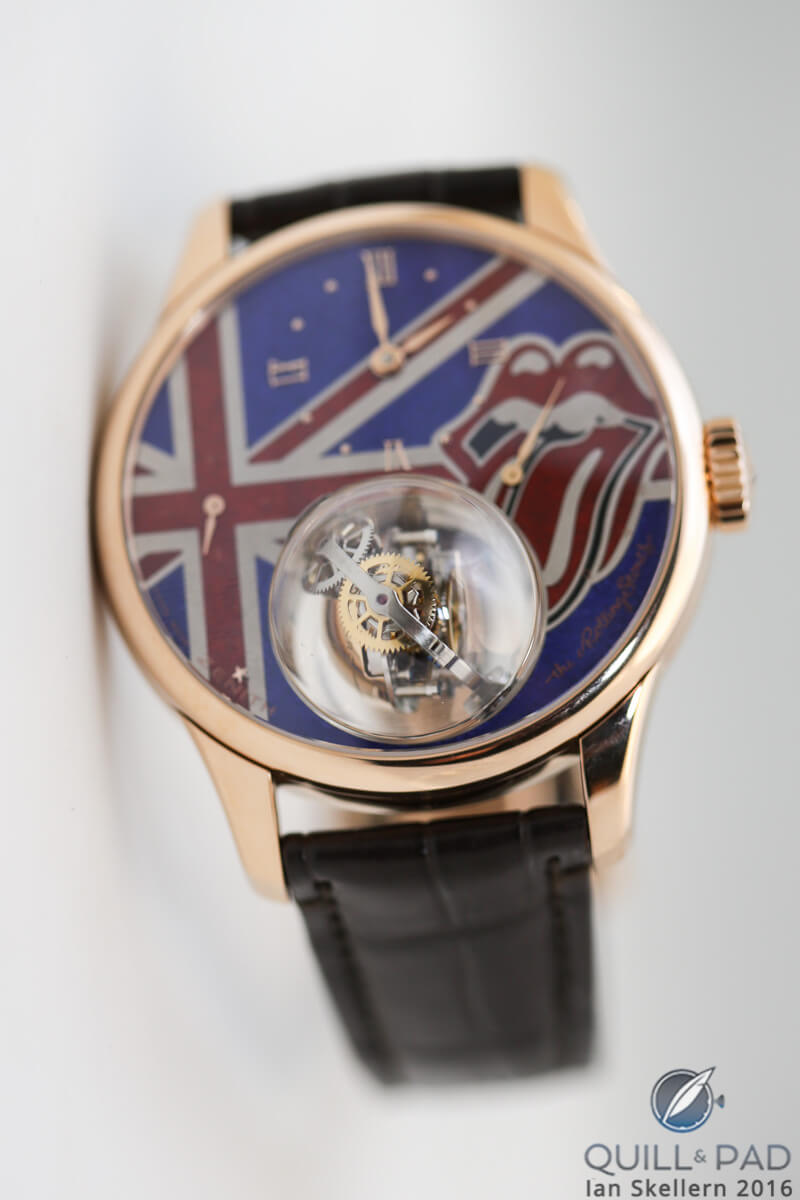The Rolling Stones haven’t lent their name to many marketing collaborations over the (nearly) half century since they’ve been one of rock and roll’s foremost acts.
However, Mick Jagger, Keith Richards, Charlie Watts, and Ronnie Woods did enter into a partnership with Zenith that resulted in a limited edition of the El Primero featuring the famous lips and tongue logo of the British rock group (see Paint It Black: Zenith (And I) On Tour With The Rolling Stones).
On March 25, 2016 the Rolling Stones performed in Cuba for the very first time.
To celebrate this milestone in the history of the band (and history in general), Zenith presented the Christophe Colomb Tribute to The Rolling Stones. It is based on a wristwatch with a quite unique technical element.
Originally christened the Zero-G in 2008, it was renamed the 0G Christophe Colomb in 2010. It is now called the Gravity Control gyroscopic module.
Depending on whether you are more interested in the Rolling Stones association or the technical aspects of this very original watch, you’ll either notice first the prominent protruding domes on both sides of the case packed full of micro-mechanical goodness or the dial’s artistic micro painting featuring a Union Jack and the Rolling Stones logo.
Not a tourbillon
Contrary to popular belief, those comfortably fitting protruding domes do not contain a tourbillon, but house a gimbaled escapement designed to cheat gravity in a different way.
Zenith’s head of movement development, Yves Corthésy, was obviously inspired by the suspension used to keep marine chronometers in their continuous horizontal position when he devised this movement.
The gimbaled frame is sometimes called a “cardanic” suspension in honor of the sixteenth-century mathematician Girolamo Cardano – who left behind a written description of the mechanism but did not claim to have invented it. Cardano was inspired by a sedan chair made for Emperor Charles V that would remain flat and stable even when traversing different inclines.

Eighteenth-century marine chronometer with gimbals and in a vacuum by Jeremy Thacker, who termed the word “chronometer” to designate precision clocks used for navigation (photo courtesy Wikipedia)
Gimbals were used to keep shipboard timekeepers in the same position no matter what position the ship was in, especially in rough seas. This clever universal joint shaft simply rotates its precious cargo when its environment is out of alignment.
Corthésy and Zenith’s engineers consciously chose to suspend the escapement they had been working on cardanically so that it would remain in the same position – and therefore exhibit the same effective rate (precision) regardless of the position of the wearer’s wrist.
The gimbaled suspension keeps the Zenith escapement in a consistently horizontal position, gyroscopically stabilizing it.
In other words, it follows the position of the wrist and corrects the effects of gravity in a perfectly natural way.
Zenith’s patented 0G system comprises a system of gears harnessing the rotations of the carriage’s axes, while a reversing differential gear instantaneously compensates for movement. The escapement located within the carriage consistently seeks out the equilibrium determined by gravity.
Unlike a tourbillon, which deliberately moves along a predetermined course of its own accord at a preset speed, the 0G system cleverly and cleanly counteracts by keeping the escapement upright.
Prominently featured under dual protruding domes accommodating the gyroscopic escapement module, the double-axis regulating organ comprising a cage of 166 components, ten conical gear wheels, six spherical wheels, and six ball bearings ensures an even rate. The manually wound Caliber Academy 8804, which beats at Zenith’s signature frequency of 5 Hz / 36,000 vph, is regulated in six positions.
Pioneering
Christopher Columbus was not a name plucked from thin air as the moniker for this complicated timepiece.
In 1916, Zenith produced an escapement called the Echappement Colon (Colón is the Spanish name for Columbus and échappement is the French word for escapement).
This Lépine-style chronometer movement was particularly accurate according to the archives: it was awarded three first prizes by Neuchâtel’s observatory and an “especially good” Class A certificate by the Kew observatory in Teddington, UK.
It makes sense to dedicate a pioneering escapement like this to a band that pioneered so much in rock and roll, now including a multi-generational audience.
So if you’re a fan of high-end watchmaking and one of the most well-known bands in the world, guess what? You can always get what you want.
For more information, please visit www.zenith-watches.com.
Quick Facts
Case: 45 x 14.35 (without sapphire crystal domes) / 21.40 mm (with sapphire crystal domes), pink gold
Movement: with gyroscopic, cardanically suspended escapement beating at 5 Hz /36,000 vph with a 50 hour power reserve
Dial: gold enamel and micro painting
Functions: hours, minutes, subsidiary seconds; power reserve indication
Limitation: 5 pieces
Price: 220,000 Swiss francs / €220,000



























































Trackbacks & Pingbacks
[…] sold out, and this first act on the wave of tribute success was followed by the haute horlogerie Academy Christophe Colomb Tribute to The Rolling Stones, which retailed for “just” a quarter of a million dollars. A fusion of red symbols including […]
[…] the 2016 Zenith Christophe Colomb Tribute to the Rolling Stones, in 2017 Zenith presents a limited edition Pilot Type 20 model that also utilizes the famous tongue […]
[…] illustrate my confusion in terms of this strategy: the Zenith Christophe Colomb Tribute to the Rolling Stones at 220,000 Swiss francs is hardly aimed at the typical Rolling Stones fan or the Millenial. So who […]
[…] perhaps except Zenith with the Rolling Stones (see The Zenith Christophe Colomb Tribute To The Rolling Stones Is A Limited Edition Of The Highest Order), but that collaboration felt so . . . so . . . corporate. The Rolling Stones wouldn’t even agree […]
Leave a Reply
Want to join the discussion?Feel free to contribute!